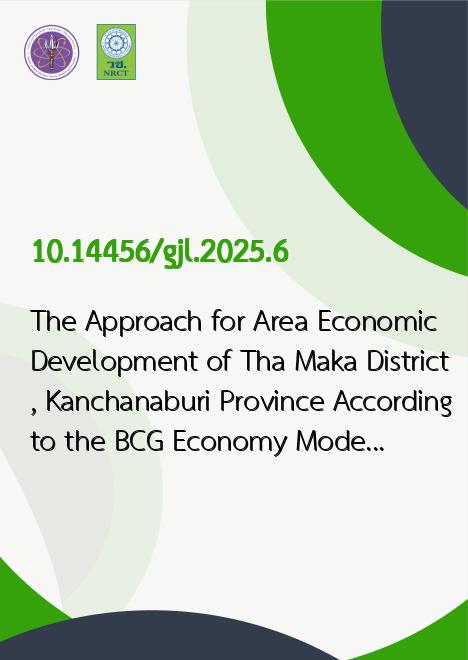
|
The Approach for Area Economic Development of Tha Maka District, Kanchanaburi Province According to the BCG Economy Model |
|---|---|
| รหัสดีโอไอ | |
| Creator | Phatharaporn Jaipheng |
| Title | The Approach for Area Economic Development of Tha Maka District, Kanchanaburi Province According to the BCG Economy Model |
| Contributor | Watcharawipat Silaparatana |
| Publisher | Department of Public Administration, Faculty of Liberal Arts, Kalasin University |
| Publication Year | 2568 |
| Journal Title | Governance Journal, Kalasin University |
| Journal Vol. | 14 |
| Journal No. | 1 |
| Page no. | 123-144 |
| Keyword | Economic Development, BCG Economy Model, Tha Maka District |
| URL Website | https://so01.tci-thaijo.org/index.php/gjournal-ksu |
| Website title | Governance Journal, Kalasin University |
| ISSN | ISSN: 3027-8589 (Online) |
| Abstract | This research was based on the needs of the community in Thamaka District, Kanchanaburi Province, to solve community problems 1) the lack of identity products of the community and 2) environmental problems to create sustainability in the area. The research objectives article were to 1) study the economic development process in Tha Maka District, Kanchanaburi Province and 2) propose the appropriate approach for area economic development according to the concept of the BCG economy model. This research was qualitative research. The key informants including, people and stakeholders in the area, using individual interviews and focus group discussion, and the data was analyzed by content analysis. The research results found that 1) people in the area utilized the waste raw materials (cow dung) as well as good raw materials (cow milk, sugar cane juice) to produce the processing products that were unique of community and 2) the appropriate guidelines for economic development in the area were 4 issues as follows: (1) context analysis, studying the possibility of processing the organic compost from cow dung for utilizing in agricultures (2) input analysis, increasing value to biomass products by using the resource circulation system and controlling the quality of activities (3) process analysis, utilizing from resources and creating the quality community products for making a safe agricultural cycle system entirely, and (4) product analysis, leading to agricultural products that possible to generate income such as sugarcane, banana, grass, etc. Overall, there will be possible to summarize the important findings from research which will be factors for success in developing the local economy, including 1) creating community researchers, 2) searching for needs, 3) integrating cooperation, 4) communicating research results, 5) emphasizing participation, 6) promoting lifelong learning, 7) developing alternative products, 8) circulating resources in the area, and 9) promoting marketing channels. The significant recommendation is that the relevant agencies should support the vocational training activities of raw materials production that consider to the environmental sustainability in the area. |
